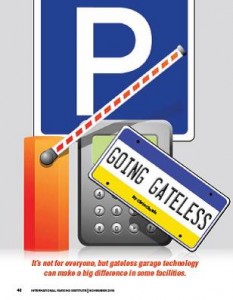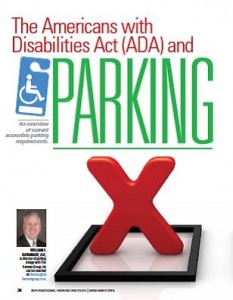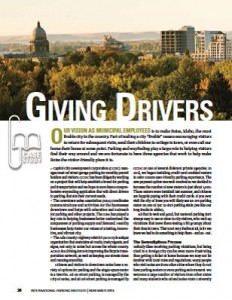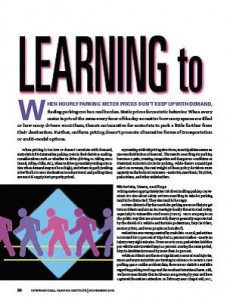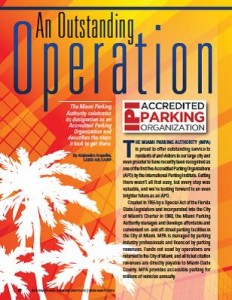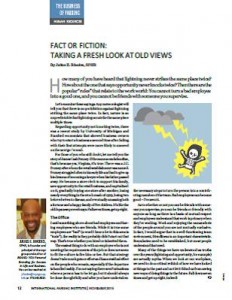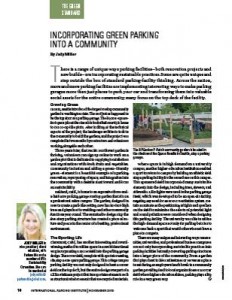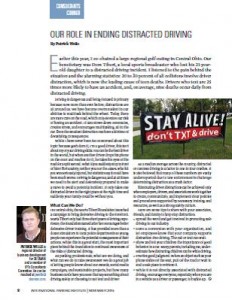Parking access revenue control systems (PARCS) remain the most popular solution deployed to manage access and payment in garage facilities. These systems provide a range of valuable solutions to deal with complex user requirements for permit and transient parkers while supporting gated access to maximize compliance and manage limited enforcement resources. However, as garage projects are introduced, parking managers are taking the opportunity to examine new technology with a fresh perspective.
The Traditional Approach
PARCS solutions that use gates, pay-in-lane, and pay-on-foot equipment, along with attendants, effectively drive compliance, accuracy, and audit trail. The gate serves the enforcement function effectively. It also enables lane ticket and radio-frequency identification (RFID) readers to identify different user credentials and pay-on-exit solutions to charge the parker for the exact amount of time used, driving customer satisfaction.
Parking validation also works well in gated facilities because customers can pay on exit and use a validation coupon to defray some cost of parking.
Can You Go Gateless?
PARCS solutions provide a level of accuracy and compliance no other solution can offer. However, if any of the following scenarios describe your operation, a gateless solution that uses multi-space pay stations may be worth considering:
Available enforcement resources and concentrated management. Enforcement personnel and management are required to support a gateless facility. It’s also ideal if the facilities being managed are in a concentrated area that can reasonably be serviced by enforcement personnel.
Large number of spaces. To get the value of having enforcement personnel visit a facility, the number of spaces needs to be large enough to drive parking and citation revenues that justify the additional staffing. A benchmark minimum of 500 spaces is a reasonable starting point unless enforcement personnel are deployed through multiple facilities in close proximity.
High throughput. A gateless solution can allow cars to get into and out of a facility faster than a PARCS solution. If bottlenecking is a significant problem, gateless may help.
Mixed-use garage with available occupancy. Gateless works best if there are always some available spaces in the garage; it reduces the risk that parkers will take up reserved spaces when they can’t find anything else.
Low validation need. A gateless solution can include pay stations with features such as coupons for validation, but they need to be provided in advance of the parking session. Therefore, it’s ideal if the facility has a low need for validations.
The Emergence of APIs, PBL, and LPR
During the past five to 10 years, three technologies have come together to deliver a new solution for garages:
Application Programming Interfaces (APIs). Technology providers are increasingly offering open API platforms with software tools and standards that allow different technologies to talk to each other, exchange data, and provide new value-added services. Some vendors are reluctant to get on the API bandwagon as there is concern that providing third-party access to their solutions will lower their competitive advantage. Customers are quickly shifting this view by demanding vendors work together as the parking industry seeks to drive new revenues and reduce costs while facing ongoing pressure to introduce new services.
Pay-by-License Plate (PBL). The license plate has been around since the car was first invented—often used by the parking industry as a common identifier for permits and reserved parking and more recently, pay-by-cell deployments. However, it has only been in the last decade that the license plate has been considered for pay station and transient parking transactions. The Calgary Parking Authority was the first to use the license plate for its proprietary on-street system in 2007, and in 2012, the Pittsburgh Parking Authority became the first U.S. city to deploy PBL on-street. PBL offers many advantages over traditional pay-and-display (PND) and pay-by-space (PBS) deployments. In many ways, it offers the best of both worlds by providing benefits to the parking operator, parking employees, and consumers. For example, a parker no longer has to go back to his/her car after making a transaction as is required for PND, and a unique identifier can be provided for the parker without having to paint numbers and stall markings as required for PBS. Zone-based rates can be implemented, and more efficient enforcement methods can be deployed with the use of mobile LPR solutions.
License Plate Recognition (LPR). LPR was invented in the early 1970s in Great Britain and used largely for police enforcement. Early systems had limitations because many license plates in Britain had black backgrounds with white and silver letters that were difficult to read. Fast forward to the 21st century, and there have been significant advancements in LPR camera technology around processing speed, optics, shutter speed, and the miniaturization of camera devices that have improved its reliability, affordability, and size for use in mobile applications. These changes naturally broadened the applications where it is used. Today, LPR can be found in many police cars and is deployed in applications such as toll highways and bridges, border crossings, and scofflaw enforcement. As pay station vendors have provisioned their hardware with alphanumeric keypads and software support for the license plate, LPR is also being used in transient parking enforcement, both on- and off-street.
With the advancement of these new technologies, there is a clear opportunity to shed traditional views on what will work in a garage. Two locations that took a fresh approach are the City of Surrey, B.C., and the University of British Columbia.
City of Surrey
When the City of Surrey created a parking authority in 2012, it was tasked with developing an entirely new approach to managing parking assets. For years, the city relied on traditional, off-the-shelf, paper-based parking processes. But with the development of a LEED-certified City Hall and multi-use garage within a newly transformed city center, the city recognized an opportunity to gather the industry’s best technology providers to collaborate—not compete—in the development of a new, all-electronic, paperless system to manage staff and public parking permits and hourly/event/validated parking.
This challenge fell on Dave Harkness, manager of parking services. When looking at the needs for this new garage, he recognized a new approach would be required. Harkness and his team identified two necessities: supporting the needs of 10 distinct user groups and finding ways to deal with traffic volume in the facility. Many city employees left at the same time, making gate deployment an unviable option without facing significant traffic bottlenecks and customer dissatisfaction.
His department envisioned a solution that involved using seven technologies from a variety of vendors that would have to work together seamlessly. Proposing this idea to various technology and service providers in a cooperative process was a daunting challenge as these companies were not traditional collaborators, and in several instances, competed against each other. Once the various partners recognized that the future salability of what they could jointly develop would exceed what they could provide individually, they covered almost all of the necessary integration and software development costs to achieve a combined technology solution.
The 835-space, three-level underground garage was completed, and a new technology solution went live in February 2014. The solution includes 10 pay stations using PBL, pay-by-cell, fixed LPR cameras at the entrances and exits, mobile LPR monitoring system, citation issuance hardware and software, an electronic permit system, and off-site registration kiosks to allow library patrons to register for free parking in an adjacent surface lot. Transient parkers now drive into the facility, where every license plate is scanned by the fixed LPR camera; a 10-minute grace period is provided to pay at one of the pay stations; and a valid transaction is recorded in a central database to facilitate tracking for enforcement. Data from pay-by-cell; permits and library kiosks are also recorded in this centralized database to provide a truly interconnected system.
The solution has proven highly successful in providing good vehicle throughput in and out of the facility while meeting the requirements of different user groups. Added benefits included eliminating costs with the administration and printing of paper permits by moving to virtual permits that allow city workers and the public to self-manage their monthly parking accounts online. The project was recognized for its innovation with an IPI Award of Merit in 2014.
Harkness says, “An open platform and collaborative mindset is perhaps one of the most important and positive trends in the parking management industry today.”
The University of British Columbia
In 2012, Brian Jones, director of parking and access services for the University of British Columbia (UBC) had a slightly different challenge. UBC, located in Vancouver, B.C., is a global center for research and teaching home to 50,000 students and consistently ranks among the 40 top universities in the world. The campus has more than 8,500 parking spaces spread out over a 1,000-acre site. UBC’s six garages had aging PARCS equipment reaching the end of its life, which resulted in high maintenance costs and regular headaches for the parking department. More importantly, customer service suffered as students, faculty, and visitors faced long waits to get into these garages, especially during high-profile events during which traffic surged for short periods of time. The parking department wanted to introduce a single technology platform for on-street spaces, surface lots, and garages.
Much like Dave Harkness in Surrey, Jones decided to remove the gates and implement PBL pay stations, Fixed LPR, mobile LPR, and virtual permits. His team conducted a four-month test at the Fraser garage, a four-floor facility built in 1982, by deploying the technology solutions outlined. The results were positive.
The test proved the technology could work well together and meet the university’s objectives of improved customer service and positive financial return. By rolling out the same solution to all six garages, Jones estimates he will save more than $4 million in capital costs that would have been required for new PARCS equipment and an additional $300,000 annual savings in employee costs.
From a strategic level, the parking department designed these solutions to promote community engagement by eliminating problems that had become a deterrent to the public from coming to campus to see world-class attractions. As Jones points out, “Parking is the first and last thing you experience on campus, so it is critical to create a good impression.”
Final Considerations
Gateless parking is not a one-size-fits-all solution and will not feed every organization’s needs. PARCS equipment will continue to be an important option to deal with the many parking challenges faced today, but advances in other technologies, such as PBL, LPR, and the APIs that tie solutions together, and new alternatives should be considered.
Chris Chettle is executive vice president and general manager of T2 Canada. He can be reached at chris.chettle@t2systems.com.

